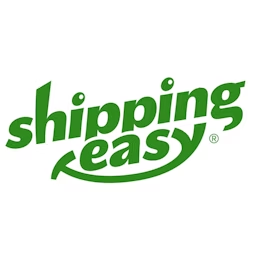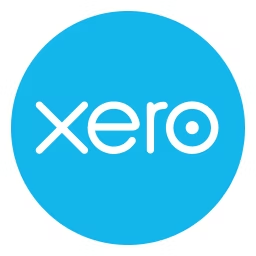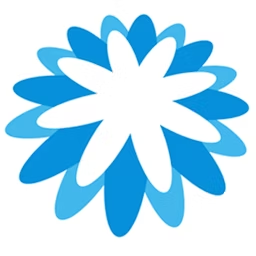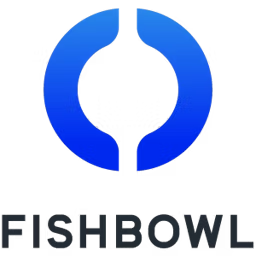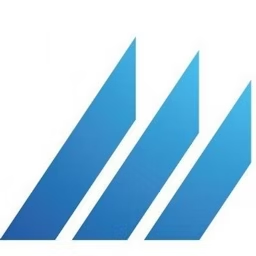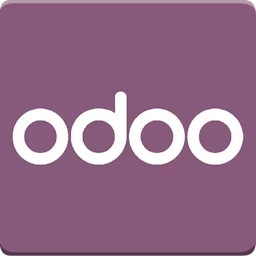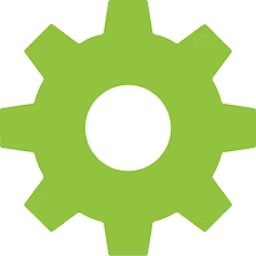In modern business operations, logistics and warehouse managers often need clarification on two software categories when purchasing a solution to help ease their logistical burdens: purchasing and supply chain management (SCM) software. While both play pivotal roles in managing the flow of goods and services within a company, their distinct functionalities and objectives set them apart.
While purchasing software seeks to optimize the product procurement process for organizations and help manage supplier relations, supply chain software is geared more towards looking after the complete supply chain process, which includes raw material acquisition, inventory management, ensuring sufficient stock availability, and overseeing the final delivery of goods to customers.
This article discusses the similarities and differences between purchasing and supply chain management software so you can select the right one for your business needs. We've also included the top five products based on verified software reviews for each software category. Read more.
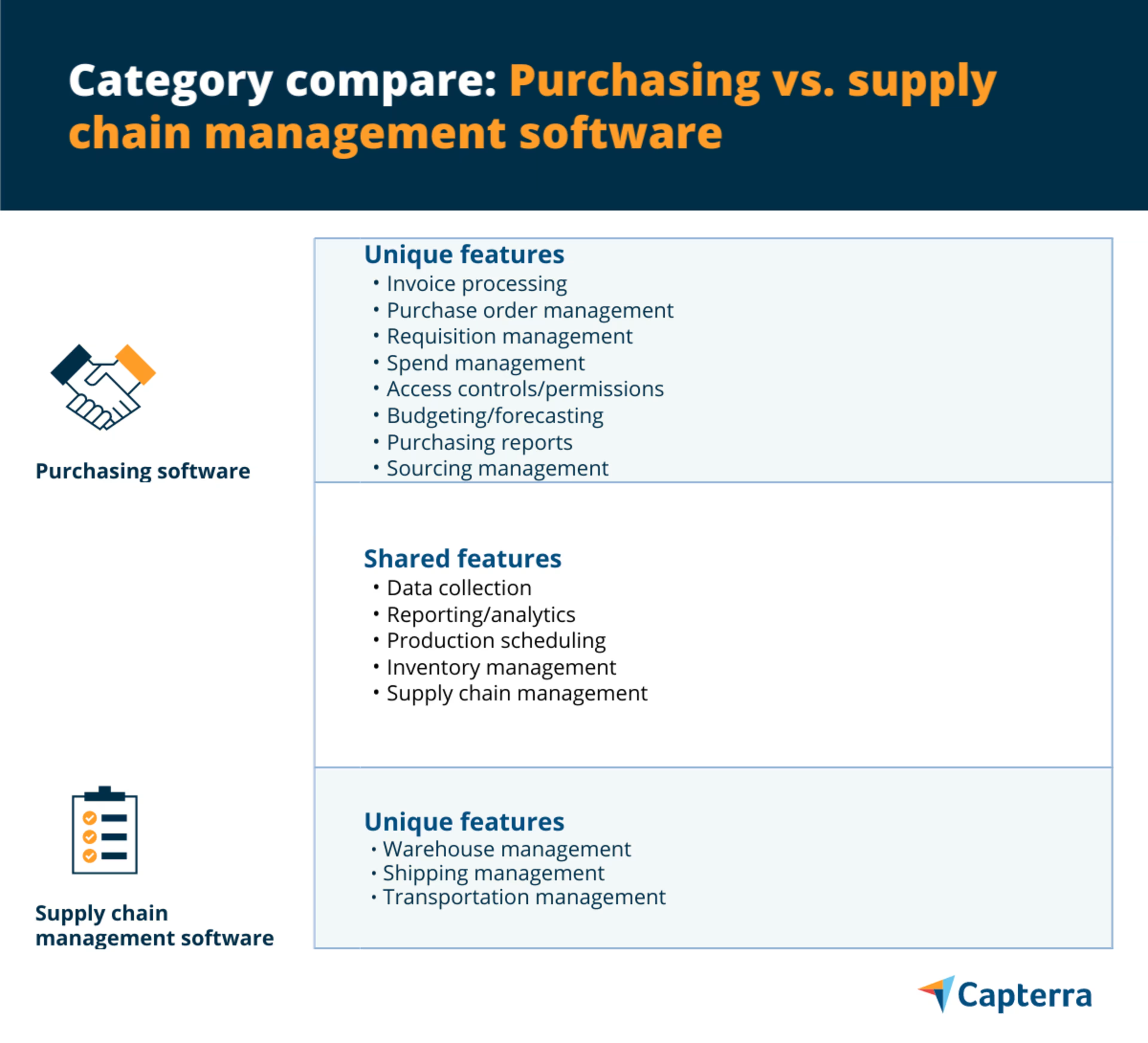
What is purchasing software?
Purchasing software automates the procurement cycle for purchasing direct and indirect goods, such as raw materials, office supplies, or machinery and equipment. The application allows employees or departments to create detailed purchase requisitions, maintain a database of approved suppliers, and create, approve, and track purchase orders. Purchasing solutions often offer integrated tools for invoice approval, inventory control, asset management, customer service, and work order management.
The primary goal of purchasing software is to enhance the procurement process's efficiency and accuracy, leading to cost savings, better supplier relationships, and improved overall procurement performance.
Procurement managers typically use purchasing software in organizations across various industries and sectors to plan and execute procurement strategies, manage supplier relationships, monitor purchasing activities, and ensure compliance with procurement policies and procedures.
Core features of purchasing software
Invoice processing: Create, process, execute, and manage supplier invoices until payment is finalized.
Purchase order management: Create, send, and track purchase orders.
Requisition management: Review, approve, and cancel requests for goods/services to be purchased.
Spend management: Track the amount spent on a particular product or a specific supplier.
What is supply chain management software?
Supply chain management software automates the flow of processes from sourcing raw materials to the delivery of finished goods to the consumer. These applications allow for organization-wide order processing, transportation, warehouse management, and resource planning and forecasting.
The primary goal of supply chain software is to enhance efficiency, visibility, and collaboration within the supply chain network, allowing businesses to reduce operational costs, minimize inventory holdingManufacturers and supply chain managers use the software to manage their inventory, track shipments, forecast demand, and identify areas for improvement, thereby ensuring a more agile and competitive supply chain.
Core features of supply chain management software
Inventory management: Track and manage the quantity of on-hand resources to maintain proper supply.
Supplier management: Manage various aspects of the supplier relationship, such as onboarding, communication records, contract agreements, and supplier performance monitoring.
Warehouse management: Help configure warehouse layout and placement of goods, allocate storage locations based on product characteristics, and optimize the flow of goods throughout the facility.
What are the differences between purchasing and supply chain software?
Business focus: Purchasing software primarily focuses on the procurement process. It helps automate purchasing activities, such as requisitioning, vendor management, purchase order creation, approval workflow creation, and invoice processing. On the other hand, supply chain management software has a broader focus encompassing the entire supply chain, from raw material sourcing to delivering finished products to customers. It aims to optimize the flow of goods and information across the supply chain network.
Integrations: Purchasing software often integrates with databases or systems that manage vendor and supplier information. This integration allows easy access to supplier catalogs, vendor performance data, and contract details. Purchasing software also integrates with accounting and finance systems to ensure that purchase orders, invoices, and payments get properly recorded and reconciled. Supply chain management software typically integrates with inventory management platforms to maintain accurate stock levels, optimize replenishment, and trigger purchase orders based on demand forecasts. Additionally, SCM software integrates with transportation management systems to coordinate the movement of goods efficiently, track shipments, and optimize transportation routes.
Pricing: The price range for purchasing software is typically between $6.50 to $180 per month. On the other hand, the price range for supply chain software generally falls between $28 to $349 per month. The variation in pricing depends on factors such as the vendor, number of users, business size, specific features included, and level of customization required.
What are the similarities between purchasing and supply chain software?
Both purchasing and supply chain management software aim to increase business process efficiency through automation. They share many similarities and help businesses automate various tasks, such as order processing, inventory management, supplier selection, and procurement, reducing manual intervention and minimizing errors. Here are some of the key similarities between the two types of software:
Inventory management: Both types of software track and manage inventory levels efficiently. They provide real-time visibility into stock levels, helping businesses maintain optimal inventory levels, avoid stockouts, and reduce inventory holding.
Supplier management: Purchasing and supply chain software facilitate supplier management by storing supplier information, performance metrics, and compliance data. These tools help businesses identify reliable suppliers, negotiate better terms, and establish stronger relationships with suppliers.
Demand forecasting: Accurate demand forecasting is essential for effective supply chain management and purchasing decisions. Both types of software include demand forecasting capabilities based on historical data and market trends.
Cost optimization: Purchasing and supply chain software help businesses optimize costs and reduce expenses by analyzing inventory, supply, and demand data and identifying cost-saving opportunities.
Purchasing vs. supply chain management software: Which one is right for your business?
Choosing between purchasing and supply chain software depends on the specific needs and priorities of your business:
If your business makes multiple purchases within a given period and wishes to automate routine tasks such as purchase order creation and approval, invoice management, and sending contracts to vendors, investing in a specialized purchasing software solution makes more sense.
If your business requires end-to-end supply chain management, including purchasing, logistics, inventory, and transport management, and also requires assessment of potential supply chain risks, such as natural disruptions or geopolitical factors, you should invest in a supply chain software solution.
Consider factors such as the complexity of your purchasing process, locations you serve, number of distribution channels, integration requirements, and customization needs to make an informed decision that aligns with your organization's unique requirements and long-term business strategy.
Once you've decided which software to use, head to our purchasing and supply chain management software category pages where you can find a sortable list of products and software reviews from verified users.
If you want to narrow down your search to only the most popular and highest-rated solutions, visit Capterra Shortlist reports for the top purchasing and supply chain tools—our reports are based on an analysis of thousands of user reviews.
How to choose between purchasing and supply chain management software
Below are a few important things to consider when selecting between purchasing and supply chain software.
Determine the scope and complexity of your purchasing and logistics requirements. If procurement and supplier management are the only focus areas for your business, having a purchasing software solution would be the ideal choice. However, getting a supply chain platform would make more sense if your company has more complex processes that involve managing inventories, keeping track of customer order shipments, and forecasting demand.
Assess the demand forecasting requirement for your business. If forecasting product demand and managing your stock inventory to meet customer demand is crucial, you should opt for supply chain software. However, if your primary focus is only managing procurement and keeping count of product stock in your warehouse, purchasing software is beneficial.
Assess the need for cost control for your business. If your primary goal is to reduce procurement-related costs, improve spend visibility, and ensure compliance with purchasing policies, purchasing software can help achieve these objectives. However, supply chain software would be a better fit if your cost-controlling measures go beyond procurement and you wish to optimize areas such as inventory management and product delivery.
5 top-rated purchasing software
These products are listed in alphabetical order. (Check how we selected them.)
To present the most up-to-date information, the product information below shows the latest real-time ratings, which may differ from the ratings values at the time this report's analysis was conducted, since new reviews may have been left in the meantime.
Trial/Free Version
- Free Trial
- Free Version
Device compatibility
Trial/Free Version
- Free Trial
- Free Version
Device compatibility
Trial/Free Version
- Free Trial
- Free Version
Device compatibility
Trial/Free Version
- Free Trial
- Free Version
Device compatibility
Trial/Free Version
- Free Trial
- Free Version
Device compatibility
5 top-rated supply chain management software
These products are listed in alphabetical order. (Check how we selected them.)
To present the most up-to-date information, the product information below shows the latest real-time ratings, which may differ from the ratings values at the time this report's analysis was conducted, since new reviews may have been left in the meantime.
Trial/Free Version
- Free Trial
- Free Version
Device compatibility
Trial/Free Version
- Free Trial
- Free Version
Device compatibility
Trial/Free Version
- Free Trial
- Free Version
Device compatibility
Trial/Free Version
- Free Trial
- Free Version
Device compatibility
Trial/Free Version
- Free Trial
- Free Version



